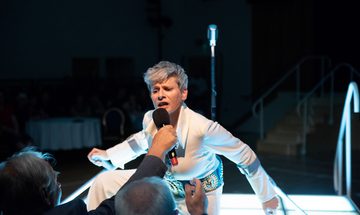“There are more effective ways of being me”: THEM! and the staging of (un)reality by Harry Wilson
Latest18 Jul 2019
News Story
Stewart Laing and Pamela Carter’s THEM! for National Theatre of Scotland explores identity, technological change and the nature of the theatrical event through a response to the 1950s sci-fi b-movie THEM!. The performance event takes place in three distinct parts and includes the staging of a TV chat show, live music, installation, film and 150,000 leaf cutter ants.
THEM! attempts to push the theatrical situation to its limits in order to examine the shifting contract between audience and performers. THEM! is at once the 1950s film and the 2019 response, it is both the fictional sci-fi remake and the theatre show we are watching, it is the TV show, the advert, the club and the sci-fi action musical.
In Stewart and Pamela’s previous work for Untitled Projects they have explored a similar kind of blurring between real and fictional worlds, between historical fact and performative re-telling. In Paul Bright’s Confessions of a Justified Sinner (2013) they invented an alternative history of Scottish theatre – one in which the visionary director Paul Bright took on James Hogg’s 19th century meta-novel through a series of audaciously staged site-specific episodes across Scotland. A mischievously convincing archive of documents, photographs and film were created to bear witness to an artistic practice that never actually, but could have, existed.
Confessions was adaptation as response – a way to re-work Hogg’s formal experimentation for a 21st century theatre audience. Described by the company as a ‘reconstruction’ of Paul Bright’s Confessions, the piece managed to tread lightly between a theatrical adaptation of, and reflection on, Hogg’s novel, as well as an examining the nature of memory and history, how we remember and what we forget.
Paul Bright’s Confessions of a Justified Sinner - Trailer (2014-15)
STAGING DISCUSSION
In much of Stewart and Pamela’s work there is a theatrical strategy of breaking through the fictional situation with a moment of staged realness. In 2009’s An Argument About Sex this took place in the third part of the piece, where Pamela’s adaptation of Pierre de Marivaux’s play La Dispute was interrupted by a filmed discussion of the performance between Stewart, Pamela and science writer Matt Ridley.
This was a post-show discussion turned mid-show deconstruction – allowing the audience to reflect on and analyse the drama that we had seen up to this point at a crucial moment in the unfolding theatrical experience.
Similarly, during the final scene change of his 2013 production of Genet’s The Maids at The Citizens Theatre, Stewart stepped in front of the theatre curtain, introduced himself as the director of the production and asked the audience if they had any questions before the final scene was performed. The production involved some provocatively non-conventional directorial decisions, including casting three young men in the female roles, staging one scene as a read through and scoring the piece with instrumental electric guitar versions of Metallica, David Bowie and the Velvet Underground (performed by the actors). The night that I watched the performance, audience members took Stewart to task about some of these decisions, embracing the opportunity to unpick their experience in the presence of the usually absent director figure.
These moments create a kind of interval in the works. A suspension of dramatic logic that creates a space for critical thinking and reflection. These moments of reflective pausing are well-suited to the ideas explored in THEM! which in part interrogates the danger of universal stories by formally disrupting conventional narrative structures.
NOT ME, NOT NOT ME
This staged realness is also explored in THEM! with Stewart and actor Kiruna Stamell appearing “as themselves”. This produces a kind of reality effect, where the character and the actor overlap. “Stewart” aligns with the real Stewart Laing, director of THEM! “Kiruna” is Kiruna, an Australian actor living in Birmingham.
But this is an effect of the real, an illusion that Stewart and Pamela take pleasure in exposing. Kiruna is playing the character of “Kiruna”. Stewart is “sort of Stewart” but speaking words scripted in advance by Pamela. We might say, then, that the Stewart we see on stage both is and is not Stewart Laing. Or, drawing on Richard Schechner’s idea of performance as restored behaviour, the performer in front of us is not Stewart Laing but he is ‘not not’ Stewart Laing.
Schechner’s theory relies on the idea that nothing we do is for the first time, but instead different behaviours are like strips of film that can be “rearranged or reconstructed” (Schechner Between Theatre and Anthropology 1985, 35). As Schechner writes, restored behaviour is:
“me behaving as if I am someone else” or “as if I am ‘beside myself’, or ‘not myself,’ ” as when in trance. But this “someone else” may also be “me in another state of feeling/being,” as if there were multiple “me’s” in each person. (37).
As THEM! develops, Pamela and Stewart push this idea of “multiple me’s” to explore identity politics, technological change and to examine the very nature of the theatrical event. As a result the piece asks:
How fluid are our identities? Is our identity limited to the physical, biological constraints of our bodies or is it something more flexible? Or, channelling Judith Butler’s ideas on gender performativity, how does our performance of identity bring that identity into being?
Without revealing too much about how this plays out in the performance, one question that was present in the research stage of the production was “who would play you in a version of your own life?”. A question which, in the context of THEM!, reminds me of Andy Warhol’s faked lecture tour in the 1960s.
In 1967 Warhol hired actor Allen Midgette to appear in his place in a series of college lectures in the USA. After Midgette’s lackluster appearance at the University of Oregon the audience suspected that he was a fake but it took a few months for Warhol’s manager to come clean. When quizzed about the hoax at a later appearance Warhol was dismissive of the idea that he was “getting away” with anything, stating that: “I actually thought Allen would do a better job and people would enjoy him much better.” As the character of Stewart says in THEM! “there are more effective ways of being me”.
Andy Warhol at the University of Oregon, 1968
MMERSION AND POST-IMMERSION
In support of this blurring of the real and the imaginary, there is often an immersive element to Stewart and Pamela’s work, where the spatial design extends beyond the limits of the playing space and surrounds the audience. In the first version of Slope in 2006 the audience walked up a 60m ramp that led to a sunken playing area where they watched the intense drama play out from above. In 2013’s TheSalon Project the experience started with the audience being fitted into opulent Victorian costumes before entering the mirrored 19th century reception room, where music, performance and guest speakers stimulated discussion amongst audience members.
In THEM! too there are distinct immersive environments created that aim to break down the separation that usually exists between audience and performer – what Kiruna refers to at one point as the “unbridgeable space between us”.
However, Stewart and Pamela’s work differs from what we may think of when we encounter the term Immersive Theatre. There is no attempt to fully immerse the audience in a fictional world, or to make them perceive the make-believe as reality. Instead, often, the audience are reminded of the theatrical artifice of the situation they are in, or the roles that they themselves are playing.
This might be thought of in relation to what Joseph Dunne-Howrie has termed “post-immersive” practices, where instead of the experience offering us an escape from reality and “denuding the individual of their agency as moral and critically aware individuals” the post-immersive foregrounds “the role the participant plays as an agent of social production … where both [artist and participant] assume responsibility for constructing a narrative”.
Instead of escaping from our immediate reality, THEM! reminds us of our political and social relations, it creates, what Dunne-Howrie terms, a “temporary community” from our “diverse subjectivities“. Stewart and Pamela do this by immersing us in the theatricality of an encounter – always not and not not, caught in the space between real and imaginary worlds.
Article by Harry Wilson, Digital Thinker In Residence
About the author
Harry Wilson
Harry Robert Wilson is a researcher and performance maker based in Glasgow and currently Digital Thinker in Residence with the National Theatre of Scotland. Harry has a PhD in intermedial performance practice from the University of Glasgow. He has shared research at a range of conferences from Stockholm to Chicago and as a practitioner has shown work at venues and festivals across the UK including The Arches; the Citizens Theatre, Glasgow; Forest Fringe, Edinburgh; DCA, Dundee; BAC, London; and internationally at Defibrillator Gallery, Chicago and Kilowatt Festival, Sansepolcro.
Twitter:
Academia.edu:


